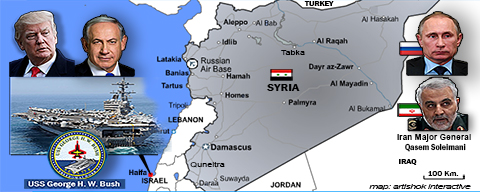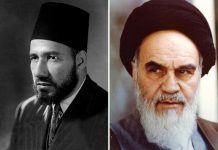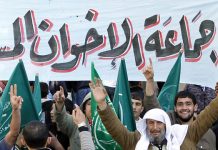Who Is the Bush carrier meant to deter? Not Iran/لردع من هي حاملة الطائرات الأميركية “بوش” التي وصلت إلى إسرايل؟ ليس لردع إيران
DEBKAfile Exclusive Report/July 01/2017
The arrival of USS George H.W. Bush on Saturday, July 1, for the first visit a US aircraft carrier has paid to Israel in nearly two decades is a happy event for the Jewish state. The 5.700-strong crew of the biggest nuclear-powered vessel in the world will be given a joyous welcome when they celebrate America’s Independence Day on July 4.
But amid the comings and goings of helicopters ferrying official VIPs and high officers between the port of Haifa and the decks of the Bush, one question remains unanswered. Why was this mighty ship, with its more than 80 warplanes and cruise missiles, deployed to the eastern Mediterranean at this time? And which bad guy is it meant to deter?
Russia is certainly not in US sights, or even the air force and naval units it has posted to Syria. Washington and Moscow are not seeminlgy poised for a direct confrontation over Syria and its ruler Bashar Assad. Since no showdown occurred in the two years since the Russians stepped up their military intervention in September 2015, it won’t be staged days before President Donald Trump’s first face-to-face with Russian President Vladimir Putin at the G20 in Hamburg, Germany.
Assad can therefore rest quietly; he is out of danger for the foreseeable future. Even the new French President, Emmanuel Macron admitted on June 22: “France is no longer pushing for the departure of Syrian President Bashar Assad.”
Washington and Moscow will no doubt have their ups and downs over military moves in Syria while carving up their spheres of influence, but Putin appears to have got away with his strategy for stabilizing the Assad regime and its future, while setting up a chain of Russian air and naval bases on the western Syrian Mediterranean coast.
Propped up by Russian air might, the regime in Damascus is additionally secured by Iran and Hizballah.
However, unlike the Russians, their presence in Syria directly imperils Israel’s national security.
When Trump entered the White House in January, he and his aides doubled down on two vows, which were to tear up the bad nuclear deal with Tehran, and boot Iran and Hizballah out of Syria. Those steps aimed at stripping Iran of the leading Middle East power status conferred on the Islamic Republic by Barack Obama; curtail its aggressive expansionism; and snatch away from Tehran the prize of a direct land bridge to the Mediterranean via Iraq and Syria.
Just two months ago, when President Trump visited Riyadh and performed his sword dance with Saudi King Salman, he repeated those vows to provide the platform for a new US-Arab Sunni pact. For a brief moment, Trump appeared to have come up with America’s answer to Putin’s Shiite Iranian-dominated bloc.
But this week, the Riyadh plan had clearly been set aside..
The US armed forces journal Stars and Stripes commented in its June 29 issue: “President Donald Trump decided against killing off the Iran nuclear deal in a Day One spectacular. It may face a lingering death instead.”
No Middle East watcher sees any sign of this happening; just the reverse. Even if Washington did walk out of the nuclear pact, it would make no difference, since, in recent months, the Iranians have fast forwarded the development of their nuclear and missile programs. They sent blunt notice of their stance last month when they fired seven ballistic surface missiles from western Iran into eastern Syria.
Not a peep came out of the Trump administration at the time. And no one stopped Tehran following up with rapid one-two steps designed by Al Qods chief Gen. Qassem Soleimani – and carried forward by Syrian, Iraqi and Iranian forces – to seize control of large parts of the Syrian-Iraqi border and open up their coveted land bridge.
This Iranian-Syrian offensive had two consequences:
1. The Iranian and allied military moves in eastern Syria hemmed in and cut off the US special forces which had set up a garrison in the Syrian-Iraqi-Jordanian border triangle.
2. While Moscow never declared its support for the Iranian-initiated move on the border, the Russians secretly helped it by supplying intelligence and logistical assistance.
On this too, Washington chose to hold its collective tongue.
On Thursday, June 29, Prime Minister Binyamin Netanyahu solemnly stated in Katzrin, at an anniversary celebration of the Golan town, that he would never permit Iranian forces to reach Israel’s border.
However, as he spoke, the Syrian army and rebel forces were locked in fierce battle just 3 kilometers away from the speaker for control of the village of Al-Baath in the Quneitra district. Netanyahu never let on that Iran had set up its military headquarters for southern Syria at Al-Baath under the command of Gen. Soleimani. Neither did he mention that Soleimani’s plan was to replicate Iran’s grab for the Syrian-Iraqi border by similar attacks on Syria’s borders with Jordan and Israel.
The fact is that the Iranians have already arrived and are sitting on Israel’s border. But the prime minister, like the US president, chooses to turn a blind eye to this rapidly advancing reality.






















